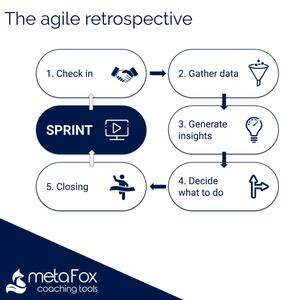Open your retrospective visually using pictures

The purpose of a retrospective is to reflect on the process of the team’s collaboration, rather than on the content of work itself. This opening icebreaker helps participants to get in a reflective mood and share their thoughts and feelings.
Goal
Help participants of a retrospective to open up, reflect on the last weeks’ collaboration process and share personal topics.
Materials
Instructions
Welcome: The facilitator welcomes everyone to the retrospective and provides context. All participants gather in a circle, so they can see and talk to each other well.
Spread the cards: The facilitator distributes a deck or a selection of picture cards with the picture facing up on the table or floor in the middle of the participants.
Card Selection: The facilitator invites all participants to choose a card. The selection process can be guided by a question, such as
Which of the pictures represents your current mood?
Which of the pictures describes the last sprint or work week for you?
Reflection & Writing (optional): The facilitator asks the participants to write the answer on the back of the card.
Sharing: Now the participants are invited to present “their” card to the team and briefly share why this card was chosen. The challenge of choosing a card, as well as the opportunity to communicate through pictures and words, provides a warm-up exercise and makes it easier to address sensitive issues later on.
Continue with retrospective
After this “soft opening” the retrospective continues with gathering more information on the last sprint of collaboration and later deciding what to change or keep doing. For more context, s. "Background" or this blog post: https://metafox.eu/deep-pictures-agile-retrospectives/
Close the retrospective:
To refer back to the opening and close the loop, you can add these steps:
Personal commitment: Everyone writes down one personal commitment that they take from the retrospective and that they want to follow up on in the upcoming days and weeks.
Collect cards: The facilitator collects the cards and puts them up on the wall of the team space. If performed regularly the exercise generates a timeline of pictures that represent each team-members’ personal situation over a week, month or sprint. They act as a reminder for the group how far they have come and what they commit to.
Attachments
- Copy of 220203-AmazonoAPlus-22.jpg
- agile retro.jpg
Background
How does a retrospective work?
A retrospective is classically held at the end of a phase of collaboration and can be divided into 5 stages, s. below. This method can be applied in stages 1, 2 or 5.
Arrival: Briefly explain the goal of the session. Allow your participants to mentally arrive. Activate them with a short check-in where everyone gets a chance to speak.
Gather impressions: What has happened recently? What worked well? What was annoying? Have an open brainstorming in which all points and thoughts are welcome.
Generate insights: Why are things the way they are? At this point, attempt to get to the bottom of the issue and analyse the collected "symptoms".
Decide on actions: What do we want to change? What behaviours and steps does this affect in everyday life? Who will initiate this change?
Closing & outlook: Look back at the session and into the future. With which feeling do participants leave the session? What are hopes and goals for the coming weeks?